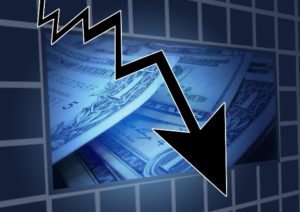

Everyone thinks that bonds, including U.S. Treasury Bonds are safe investments. Think again. If interest rates, which are at historical lows, rise, the market prices of bonds go down. Longer term bond prices go down real far down, and mutual funds that invest or trade bonds, will get hardest hit, and this has nothing to do with a credit rating, or the issuers’ ability to pay.
The Effect Of Interest Rates On Bonds
For example, if interest rates are 4%, and double to 8%, a thirty year bond which was purchased at par, let us say $100 per bond, would by definition lose 40% of its value.
Now of course, you could continue to hold the bond for thirty years, religiously received your 4% interest, and yes, at the end of the day, in thirty years, get your $100 back (and except for the opportunity cost of not investing at 8%) technically not lose a dime.
But if you want to sell your bond anytime within the next thirty years, you will be subject to market forces, and when interest rates, using our example double to 8%, instead of having to invest $100 to get that $4 annual income stream, you will only have to invest $50, at 8% to get that same $4 annual income stream, and after that same thirty year period (give or take) get your $100 back.
Mutual funds that trade these securities, balance the yield curve, or the average duration of a portfolio, along with other neat tricks portfolio managers do, they buy and sell bonds, and unlike the person that can hold the bond for thirty years and not sustain “realized” losses, mutual funds that trade in bonds, even U.S. government bonds, will suffer substantial losses.
Accordingly, when interest rates go up, bond prices (and bond fund prices) go down.
FINRA Issued An Investor Alert
Today, the Financial Industry Regulatory Authority issued an “Investor Alert” disclosing to investors, apparently the ones that didn’t know or based upon the misrepresentations of their stockbroker thought that they owned “conservative” investments, that if interest rates rise, “outstanding bonds, particularly those with a low interest rate and high duration may experience significant price drops.”
According to FINRA, “A bond fund with 10-year duration will decrease in value by 10% if rates rise one percentage point.” Also according to the FINRA Alert, “Short duration doesn’t mean risk-free.”
The complete FINRA Alert states:
What an Interest Rate Hike Could Do to Your Bond Portfolio
If you own bonds or have money in a bond fund, there is a number you should know. It is called duration. Although stated in years, duration is not simply a measure of time. Instead, duration signals how much the price of your bond investment is likely to fluctuate when there is an up or down movement in interest rates. The higher the duration number, the more sensitive your bond investment will be to changes in interest rates.
Currently, interest rates are hovering near historic lows. Many economists believe that interest rates are not likely to get much lower and will eventually rise. If that is true, then outstanding bonds, particularly those with a low interest rate and high duration may experience significant price drops as interest rates rise along the way. If you have money in a bond fund that holds primarily long-term bonds, expect the value of that fund to decline, perhaps significantly, when interest rates rise.
How Bond Duration Risk Affects Price
Many factors impact bond prices, one of which is interest rates. A maxim of bond investing is that when interest rates rise, bond prices fall, and vice versa. This is known as interest rate risk. But just as some people’s skin is more sensitive to sun than others, some bonds are more sensitive to interest rate changes than others. Duration risk is the name economists give to the risk associated with the sensitivity of a bond’s price to a one percent change in interest rates.
The higher a bond’s duration, the greater its sensitivity to interest rates changes. This means fluctuations in price, whether positive or negative, will be more pronounced. If you hold a bond to maturity, you can expect to receive the par (or face) value of the bond when your principal is repaid, unless the company goes bankrupt or otherwise fails to pay. If you sell before maturity, the price you receive will be affected by the prevailing interest rates and duration. For instance, if interest rates were to rise by two percent from today’s low levels, a medium investment grade corporate bond (BBB, Baa rated or similar) with a duration of 8.4 (10-year maturity, 3.5 percent coupon) could lose 15 percent of its market value. A similar investment grade bond with a duration of 14.5 (30-year maturity, 4.5 percent coupon) might experience a loss in value of 26 percent. The higher level of loss for the longer-term bond happens because its duration number is higher, making it react more dramatically to interest rate changes.
Duration has the same effect on bond funds. For example, a bond fund with 10-year duration will decrease in value by 10 percent if interest rates rise one percent. On the other hand, the bond fund will increase in value by 10 percent if interest rates fall one percent. If a fund’s duration is two years, then a one percent rise in interest rates will result in a two percent decline in the bond fund’s value. A two percent increase in the bond’s fund value would follow if interest rates fall by one percent.
Variables such as how much interest a bond pays during its lifespan as well as the bond’s call features and yield, which may be affected by changes in credit quality, play a role in the duration computation. Maturity — the length of time before the bond’s principal is repaid — also plays a role. Math aside, once you know a bond’s or bond fund’s duration, you can predict how it will react to a change in interest rates.
Bond Duration Details
To find your bond fund’s duration, look for it in the fund’s Fact Sheet, often in the Bond Holding Statistics section. Finding the duration of an individual bond can be a bit trickier. Start by asking your investment professional or the bond’s issuer. There are also online calculators available that compute an individual bond’s duration.
In some cases, more than one duration number is computed. For example, Macaulay Duration calculates a bond’s basic duration, while Modified Duration is a modified Macaulay computation that directly measures price sensitivity. Effective duration, on the other hand, is often the calculation cited for bonds with features that change when interest rates change, such as redemption features.
Also, duration for floating rate securities is different and generally shorter than fixed-rate securities of equal maturity, due to the periodic interest rate resets.
Finally, duration assumes that for every movement in interest rates, there is an equal change in bond price in the opposite direction. However, this isn’t always the case. For example, when interest rates drop, a residential mortgage-backed security (a bond backed by home loans) might not see an equal increase in the bond’s price, because it might prompt homeowners to refinance their loans. This in turn may limit increases in the bond’s price as it loses interest paying loans being paid off. Investment professionals use the term “convexity”; to describe this relationship.
Low Bond Duration Does Not Mean Low Risk
Just because a bond or bond fund’s duration is low, it does not mean your investment is risk-free. In addition to duration risk, bonds and bond funds are subject to inflation risk, call risk, default risk and other risk factors. These factors will be discussed in a bond’s offering document or a bond fund’s prospectus. For a more complete discussion of bond risk factors, visit FINRA’s Smart Bond Investing.
Guiliano Law Group
If you have been the victim of securities fraud you should consult with an attorney. The practice of Nicholas J. Guiliano, Esq., and The Guiliano Law Group, P.C., is limited to the representation of investors in claims for fraud in connection with the sale of securities, the sale or recommendation of excessively risky or unsuitable securities, breach of fiduciary duty, and the failure to supervise. We accept representation on a contingent fee basis, meaning there is no cost unless we make a recovery for you, and there is never any charge for a consultation or an evaluation of your claim. For more information contact us at (877) SEC-ATTY.








